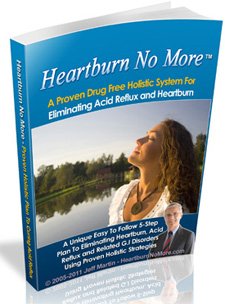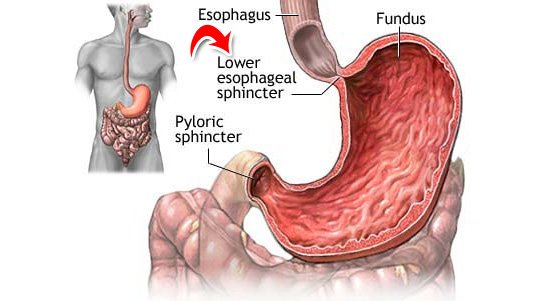
Why I Purchased The Heartburn No More System?
I invested in HBNM simply because I wasn’t happy with the standard approach taken by most health care specialists in managing acid reflux (suppress the symptoms through medication). In fact, symptomatic relief via medications only worsens the patient’s condition. At best, their approach merely provides temporary respite from the pain and sufferings due to the symptoms – but does not address the real cause or causes of acid reflux.
So many people have just dealt with Acid Reflux their whole life, and believe the only thing they can do is live with the discomfort. Heartburn No More System shares better and long-term solutions that can give readers a better quality of life. I STRONGLY recommend that you try Heartburn No More.
What Is Acid Reflux & Why Do People Have It?
Acid reflux, also called GERD or Gastro-Esophageal Reflux Disease, is a condition where the acidic substance from the stomach flows back up into the esophagus or the food pipe. The back flow of stomach acid occurs if the lower esophageal sphincter fails to close properly.
The lower esophageal sphincter is a circular muscle located at the top of the stomach and acts as some sort of a gate valve that prevents stomach liquid from flowing back up into the esophagus. Normally, the lower esophageal sphincter contracts as soon as food has passed through it. However, there are times when it doesn’t close tightly enough especially when it opens more frequently like when you go binge eating.
The sphincter needs to close or to constrict and must remain constricted all the time because once food gets into the stomach, the stomach walls start producing acid through the parietal cells to digest the food. This is part of the digestive process. The walls of the stomach are well adapted to the high level of acidify and are therefore adequately shielded from being harmed by the acid. Specifically, the mucous cells in the stomach walls produce enough mucous to coat the stomach walls entirely thus protecting them from the highly acidic, low pH environment of the stomach.
If the lower esophageal sphincter fails to close properly, a small amount of stomach acid flows back up into the esophagus irritating and inflaming its walls and produces that burning sensation. The walls of the esophagus are not like the stomach walls – they are not coated heavily with mucous. Over time, the constant and repeated flowing back of the acidic substance from the stomach up to the esophagus will ultimately damage the wall linings of the esophagus.
Visit the official website of the Heartburn No More Program or keep reading to learn more about the Acid Reflux.
Symptoms of Acid Reflux
Every time when acidic substances from the stomach leak and touch the linings of the esophagus it produces a burning sensation and other symptoms – which are actually our immune system’s defensive reaction to the presence of acidic substance in the esophagus. In other words, these defensive reactions of the immune system which we now come to recognize as symptoms of acid reflux are our immune system’s way of telling us there is an imbalance inside our body which needs to be corrected.
No one can really be quite certain what exactly causes the lower esophageal sphincter muscle to malfunction but there are a number of contributory risk factors which have been identified. The common symptoms or warning signs of acid reflux include heartburn, a discomfort or burning pain which moves from the stomach to the chest, abdomen, or throat and regurgitation or bitter-tasting or sour acid which backs up in the mouth or throat.
Other Commmon Symptoms of Acid Reflux or GERD
The person may also experience bloating and gas after meals, black or bloody stools, or bloody vomiting, dysphagia or the narrowing of the esophagus which produces a “food stuck in the throat sensation”, feeling of extended fullness, burping, belching, gas, flatulence, rippling, gurgling sensations, frequent hiccups, nausea, weight loss for no apparent reason, chronic sore throat, hoarseness, persistent dry cough, or wheezing, erosion of tooth enamel, diarrhea and constipation.
GERD Symptoms May Vary in Severity
If you remember what I said earlier – it is the lower esophageal sphincter muscle which acts as a one-way gate valve that opens automatically to allow food to enter the stomach and then closes promptly to prevent the acidic content of the stomach to flow back into the esophagus. It means acid reflux can only happen if the lower esophageal sphincter muscle “relaxes” or becomes weak or loosens up – preventing it from constricting fully. It means the lower esophageal sphincter muscle is unable to function properly – staying open when it has to be closed or constricted.
In this context, we can safely say that the onslaught of acid reflux symptoms may vary in severity according to 3 things:
- The muscular tone of the lower esophageal sphincter muscle – a weaker LES muscle will leave a bigger opening allowing more stomach acid to flow back.
- The level of acidity and pH of the liquid flowing back into the esophagus.
- The ability of the esophagus muscles to naturally cleanse the impurities that may have accumulated at the bottom of the esophagus – the impurities can lead to infection of the LES muscle which may weaken it.
How Often You Experience This Burning Sensation?
According to a recent study, about 60 percent of the population experiences acid reflux symptoms (particularly heartburn or pyrosis – another name for heartburn) at least once within a year. About 20 to 30 percent of the population experiences the symptoms on a weekly basis. Based on another survey, people who experience GERD symptoms on a weekly basis have been affected by these symptoms for five years. The number of people who were diagnosed with primary and secondary Gastro Esophageal Reflux Disease has also dramatically risen by a whopping 216% from 995,402 in 1998 to 3,141,965 in 2005.
You Don’t Have To Be One Of Them!
Trust Me! You don’t have to be one of them. Try Heartburn No More System Today and get rid of heartburn forever!

Leave A Comment